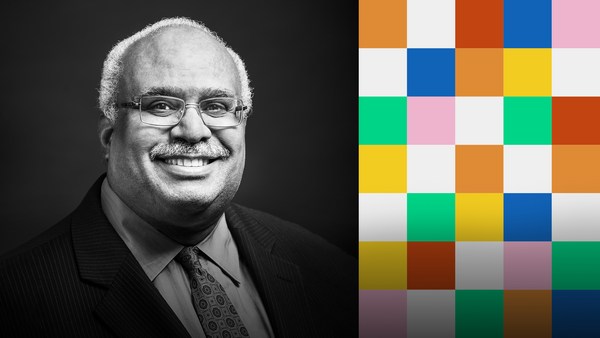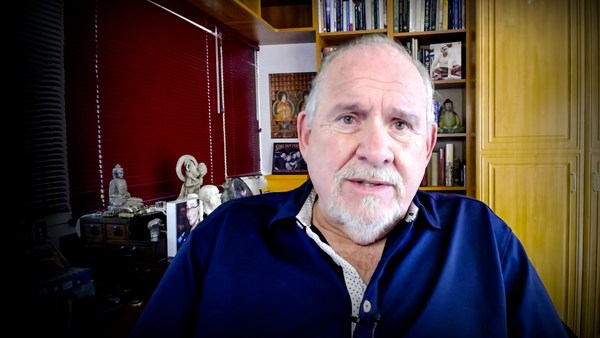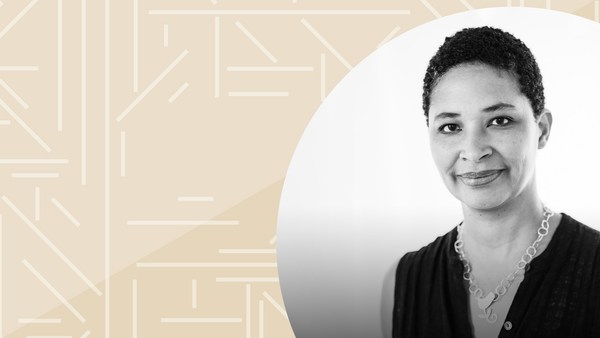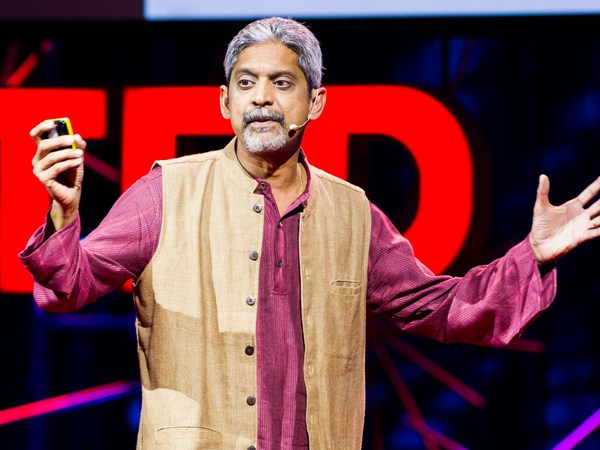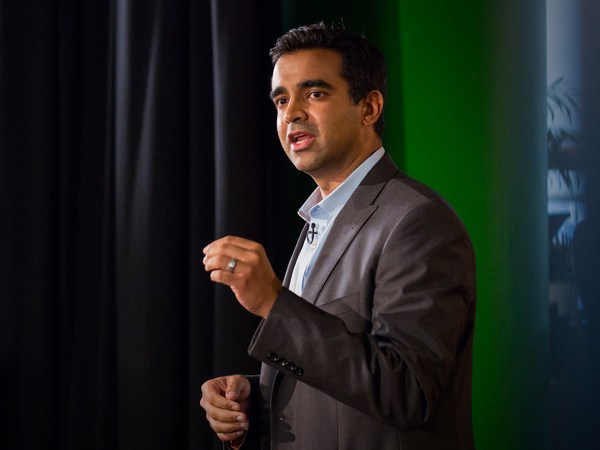Chris Anderson: Joia, both you and Partners In Health have spent decades in various battlegrounds, battling epidemics. Perhaps, for context, you could give us a couple examples of that work.
Joia Mukherjee: Yeah, so Partners In Health is a global nonprofit that is more than 30 years old. We started famously in Haiti in a squatter settlement, people who were displaced. And when we talked to them, they wanted health care and education, houses, jobs. And that has informed our work, that proximity to people who are suffering. When you think about health care and the poor, there is always disproportionate suffering for people who have been historically marginalized, like our communities that we serve in Haiti. And so we've always tried to provide health care for the poorest people on earth. And we were launched into an international dialogue about whether that was possible for drug-resistant tuberculosis, for HIV. Indeed, for surgery, for cancer, for mental health, for noncommunicable diseases. And we believe it's possible, and it is part of the basic human right to care. So when COVID started, we saw this immediately as a threat to the health of people who were the poorest. And Partners In Health now works in 11 countries, five on the African continent, Latin America and the Caribbean, as well as the former Soviet Union. And we immediately prepared to scale up testing, contact tracing, treatment, care, and then saw that it wasn't being done in the United States in that way. And in fact, we were just sitting, passively waiting for people to get sick and treat them in hospital. And that message got to the governor of Massachusetts, and we started supporting the state to do contact tracing for COVID, with the very idea that this would help us identify and resource the communities that were most vulnerable.
CA: So it's really quite ironic that these decades of experience in the developing world and elsewhere, that that has now really been seen as a crucial need to bring to the US. And especially to bring your expertise around contact tracing. So, talk a bit about contact tracing, why does it matter so much, and what would, I don't know, a perfect contact tracing setup look like?
JM: Well, first I want to say that you want to, always, in any type of illness, you want to do prevention, and diagnosis and treatment and care. That is what comprehensive approaches look like, and that "care" piece, to us, is about the provision of social support and material support to allow people to get the care they need. So that might be transportation, it might be food. So when you look at that comprehensive approach, for an infectious disease, part of prevention is knowing where the disease is spreading and how it's spreading and in whom it's spreading, so that resources can be disproportionately put to the highest-risk areas. So contact tracing is a staple of public health and what it means is that every time a new person is diagnosed with COVID or any infectious disease, then you investigate and innumerate the people they've been in contacts with, and call those contacts and say, "You've been exposed," or talk to them, "You've been exposed, these are the things you need to know. First of all, how are you? Do you need care yourself?" And facilitating that. "Second of all, these are the information you need to know to keep yourself safe. About quarantine, about prevention." And again, this would be with any infectious disease, from Ebola, to cholera, to a sexually transmitted disease like HIV. And then we say, "OK, knowing what you know, do you have the means to protect yourself?" Because often the most vulnerable do not have the means to protect themselves. So that is also where this resource component comes in and where equity is so critical to making this disease stop and also getting the information and the resources to people who need them the most.
CA: And in a pandemic, the people who need them the most, the most vulnerable, as you say, are probably also -- That's where the disease is spreading a lot. It's in everyone's interest to do this. You're not just making this sort of, wonderful, equity moral point that we've got to help these people. It's actually in all of our interest, right?
JM: Yes. Yes, we are one humanity, and any disease, any infectious disease that is spreading is a threat to all of us. And that is one of the pieces, there's the moral imperative, there is the epidemiologic imperative, that if you can't control these diseases everywhere, that it's a threat anywhere. And so as we look to the kind of society we want to live in, good health is something that gives us all so much return on our investment.
CA: Now, some countries were able to use contact tracing almost to shut down the pandemic before it took off in that country. The US was unable to do that, and some people have taken the view that therefore, contact tracing became irrelevant, that the strategy was mitigation, shut everything down. You've argued against that, that even in a process of lockdown that actually contact tracing plays a key role. Help us understand the scale, when there's a lot of cases, the scale of tracing, both cases and everyone they may have been in contact with and their contacts. It quickly gets to a huge problem.
JM: It's massive.
CA: What sort of workforce do you need to make a difference at this moment, where the US is at?
JM: It's massive. I mean, the scale is massive, and we should not take that lightly. And we don't, at Partners In Health. I mean, we are willing to try to figure this out, and I always feel that if we could stop Ebola in some of the poorest countries in the world, of course we ought to do it here, and was it too late when there were 28,000 deaths in Ebola? Sure, it's always too late. We should have started earlier, but it's not too late to have an impact. And so there's three aspects of timing and scale. First is, the earlier you start, the better, right? And that's what we saw in Rwanda. They went from early testing and contact tracing, the first two cases entered into the country on March 15, and in one month, because of contact tracing, isolation and plenty of testing, they had held that case rate to 134 people. It's remarkable, it's remarkable. In the state of Georgia, where is home to the CDC, similar population size, about 12 million, from the first two cases in the first month, those cases became 4,400 cases. And in the country of Belgium, a similar population, those two cases became 7,400. So you do have to make scale to stop this. But the earlier you do it, the more benefits there are to your society and also to the other people who need medical services -- women who are pregnant, people who need their fracture repaired, because services themselves in the United States have been, you know, really hampered by this huge amount of COVID. So the first point is, it's always late, but it's never too late. Why? Because vulnerable populations are sitting ducks, and so imagine if one of your contacts was a nursing assistant who worked in a nursing home. We know that one nursing assistant can spread it throughout a nursing home. And is it important to identify that person as a contact and assure that he or she is able to remain quarantined? That is critical. And so it's hard to say, "Well, it's not worth it if it's just one person, two persons." Every life matters, and all of their contacts in the community of that person matters as well. So that's one thing. The second about scale is people need jobs right now. And they want to be part of a solution, and some of the frustration we see, the antilockdown movement, is really out of anger and frustration and feeling, "What can we do?" And so this gives people this feeling that they're part of a solution and can provide thousands of jobs. And then third, I would say, for us to reopen our schools, our churches, our workplaces, we have to know where the virus is spreading so that we don't just continue on this path. And so contact tracing provides the platform to control, but also to see outbreaks in real time popping up, and then respond promptly. So there are many reasons that we have to bring this to scale now. Even though it is tardy.
CA: So especially as we have this pressure to go back to work, like, contact tracing has to be part of that strategy, or we're just inviting another disaster in a few weeks' time. Whatever you make of what's happened during this mitigation process.
JM: Exactly, exactly. Exactly, and so that's such an important part, Chris, and something that we are just really keen to look at the United States in a different way. What are the long-term public health infrastructures that we need to protect us for the second wave, the third wave and in the future, for future pandemics?
CA: Whitney.
Whitney Pennington Rodgers: You know, to that point, there is a question out there from one of our anonymous community members, about why contact tracing isn't already part of our public health system. It seems like it does make a lot of sense its a way to mitigate the spread of disease. Could you speak a little bit to that?
JM: I think many people have said -- and I am not a politician -- that our American health care infrastructure is built on treatment and not prevention. It's built on procedures and not keeping people well. And some of that was driven by profit, and some of that was driven by need, but I think we need to rethink how we deliver care in this environment.
WPR: "There is some fear and suspicion about privacy and contact tracing. How can we build trust in the process?"
JM: Yeah, that's a great question, and I think there's fear about privacy and part of it comes from the idea of what contact tracing is. And I think that's why we feel strongly, is if you lead with the idea that it's care and it's trying to get resources and information and help to people, it seems very different than just, oh, who's sick, and who's a threat. And so fundamentally -- and that's why we're so pleased to be at this TED talk today -- is it's about communication, right? It's not about surveillance, it's about communication and care and support. That's one thing. And we'll be hearing from our colleagues on the tech side. There's ways to add tech, even to care, that it can be a resource for caring and communication. But there are ways to protect people's privacy and also to provide care, and public health has many laws attached to it. This is all done within the constructs of our state public health laws. And so I think some of the communication around this is, how do we take care of each other, how do we take care of the most vulnerable. And if we frame contact tracing as care, I think that starts a different kind of conversation.
CA: Mm. So, Joia, can you just talk in a bit more detail about what it is that you are advising Massachusetts to do in terms of contact tracing. Give us a sense of the scale of it.
JM: Yeah, so the scale -- thank you. You know, we are able now to make about 10,000 calls a day to contacts. So every new case that comes in, the case is investigated by someone on the phone, and then those investigations means writing down the names and the phone numbers of the persons you've been in contact with for the time you were sick and a couple days before. And with those numbers then, the contact tracers -- And that's what we really redoubled the workforce and really expanded, more than doubled, to support the department of public health to do that contact tracing. So we have 1,700 people employed full time, with benefits, to call those contacts and say, "Are you OK? This is the information you need," and then, and I think this is the critical piece, when someone doesn't have the information, then we have another cadre of people we call the resource care coordinators, who help that person, that contact, to do the things they need to do to protect themselves. It might be food delivery, it might be filing for unemployment benefits, it might be trying to get them medical care or a test. That piece is the care piece. And that is what turns social distancing from very regressive -- look at me in my beautiful house, social distancing -- to something that's progressive and paying attention to those who need the resources. So the scale is massive, with 1,700 employees hired to do this, but they are connected with local community food banks and churches and facilities and primary health care centers as well.
CA: Thank you so much, Joia.
